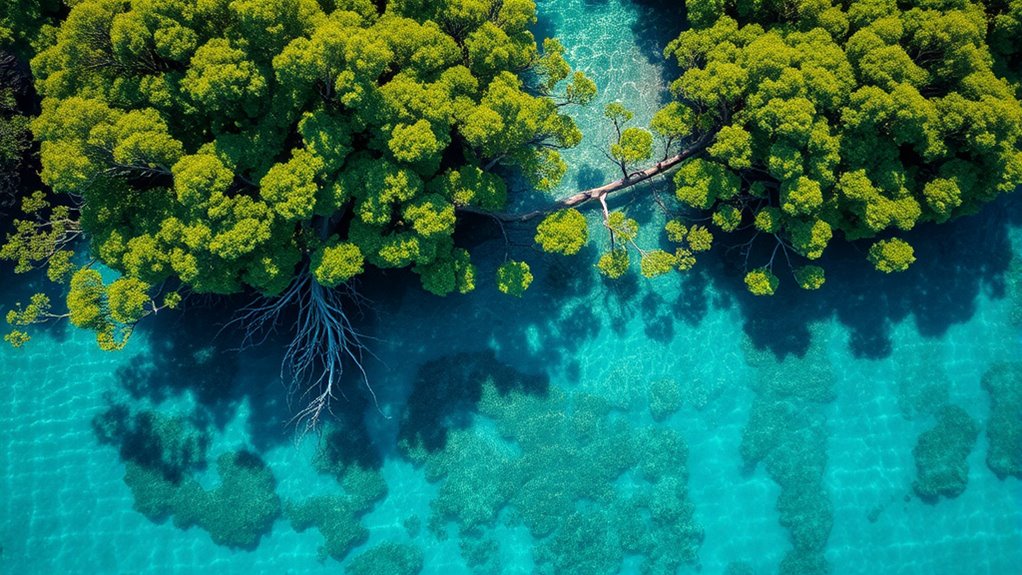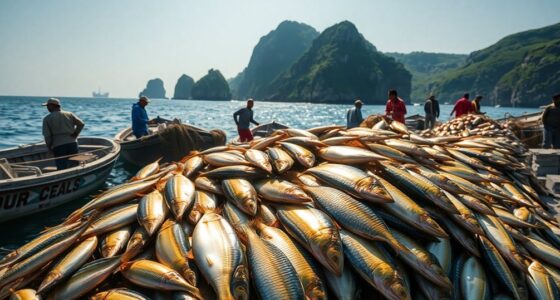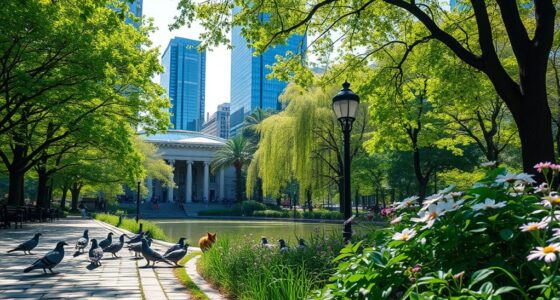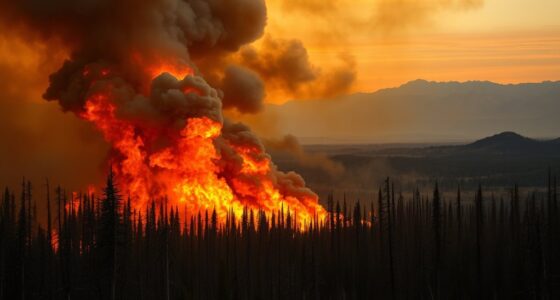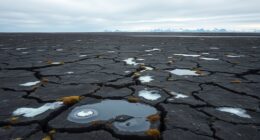Mangroves and seagrasses are powerful natural tools that store large amounts of blue carbon, helping to fight climate change. They protect coastlines from erosion, provide essential habitats, and support local economies through fishing and tourism. By absorbing and storing carbon for decades, these ecosystems play a vital role in reducing greenhouse gases. Discover how conserving and restoring these key habitats can release their full potential and benefit everyone involved.
Key Takeaways
- Mangroves and seagrasses are vital blue carbon sinks that absorb and store significant amounts of atmospheric CO₂.
- Protecting these ecosystems enhances their capacity to sequester carbon and mitigate climate change effects.
- Restoring degraded mangroves and seagrasses increases blue carbon storage and promotes ecosystem resilience.
- These habitats provide critical coastal protection, supporting communities while maximizing carbon sequestration.
- Investing in blue carbon ecosystems offers a natural, sustainable solution to reduce greenhouse gases globally.
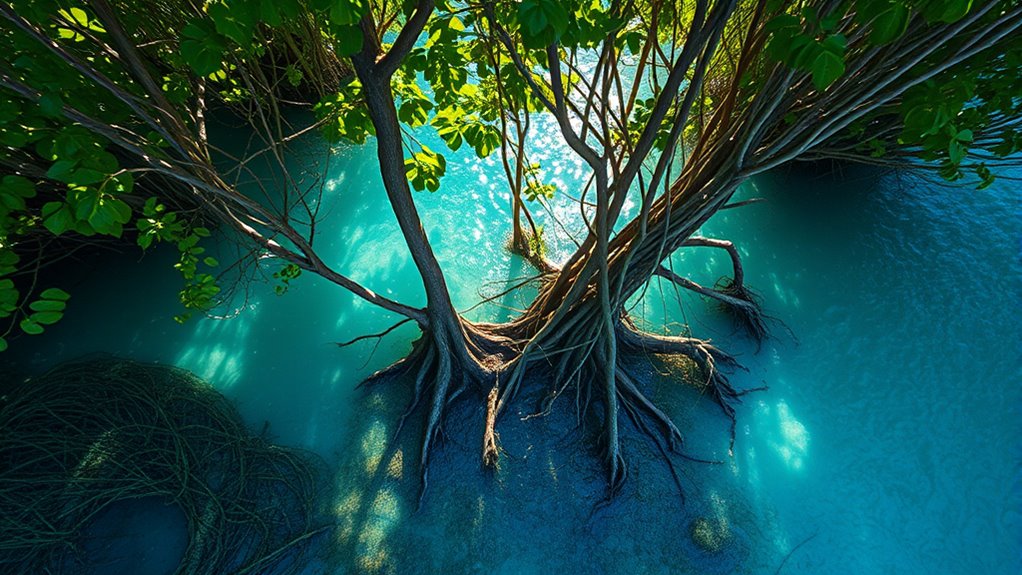
Have you ever wondered why mangroves and seagrass ecosystems are essential to our oceans? These critical habitats do more than just look beautiful. They serve as natural barriers that protect coastlines from the damaging effects of coastal erosion. When storms or high tides hit, mangroves and seagrasses absorb wave energy, reducing the impact on shorelines and helping to prevent land loss. Without them, coastlines become more vulnerable to erosion, which can threaten communities, infrastructure, and local economies. Their role in stabilizing sediments prevents the gradual washing away of beaches and coastal lands, making these ecosystems indispensable for shoreline resilience.
Beyond protecting coastlines, mangroves and seagrass beds are some of the most important biodiversity hotspots in the world. They support a rich variety of species, from tiny invertebrates to large fish, birds, and even mammals. These ecosystems provide breeding grounds, nurseries, and feeding habitats that sustain marine biodiversity. When you consider the diversity thriving within these habitats, it’s clear they play a critical role in maintaining healthy ocean ecosystems. Their complex root systems and dense plant life create a safe haven where juvenile fish can grow and where many species find shelter from predators. Maintaining these habitats also supports professional camper conversion services, which often incorporate eco-friendly and sustainable materials to minimize environmental impact. Protecting these hotspots isn’t just about saving individual species; it’s about preserving the intricate web of life that sustains our oceans and benefits local communities reliant on fishing and tourism.
Mangroves and seagrasses also act as powerful carbon sinks, capturing and storing large amounts of blue carbon—carbon stored in coastal and marine ecosystems. This capacity to sequester carbon helps mitigate climate change, making these ecosystems invaluable in our efforts to reduce greenhouse gases. Their ability to lock away carbon for decades or even centuries is often overlooked, yet it’s essential in balancing global carbon budgets. Restoring and conserving these habitats enhances their blue carbon storage potential, providing a natural solution to combat rising temperatures and ocean acidification.
Frequently Asked Questions
How Do Blue Carbon Ecosystems Compare to Terrestrial Forests in Carbon Storage?
You might wonder how blue carbon ecosystems compare to terrestrial forests in carbon storage. Blue carbon ecosystems, like mangroves and seagrasses, are highly efficient in carbon capture, often surpassing terrestrial forests in their comparative efficiency. Their ecosystem resilience allows them to store carbon long-term, even under changing conditions. This makes them crucial in climate mitigation efforts, offering a unique advantage over terrestrial forests for sustainable carbon storage and ecosystem stability.
What Are the Main Threats to Mangroves and Seagrass Beds Globally?
Imagine losing these crucial ecosystems just as they shelter diverse life and store carbon. Pollution impacts from oil spills and plastic waste devastate mangroves and seagrass beds, while unchecked coastal development destroys their habitats. Climate change accelerates their decline, threatening their ability to sequester carbon. You must act now to curb pollution and regulate development, protecting these irreplaceable blue carbon ecosystems before they vanish forever.
Can Blue Carbon Ecosystems Recover From Extensive Damage?
You might wonder if blue carbon ecosystems can bounce back after extensive damage. The answer depends on ecosystem resilience and the implementation of effective restoration techniques. If you act quickly and use proper methods like replanting mangroves or seagrass and restoring hydrology, these ecosystems can recover substantially. While full recovery can take years or decades, proactive efforts and ongoing care increase the chances of restoring their essential blue carbon functions.
How Do Local Communities Benefit From Blue Carbon Conservation?
You benefit from blue carbon conservation through community engagement that empowers you to protect essential ecosystems. When you incorporate traditional practices, you help preserve these habitats, ensuring they continue to provide benefits like coastal protection and improved fisheries. Your participation fosters sustainable livelihoods, promotes cultural heritage, and enhances resilience against climate change. By actively engaging in conservation efforts, you directly contribute to the health of mangroves and seagrass, securing benefits for your community now and in the future.
What Policies Are Most Effective in Protecting Blue Carbon Habitats?
They say “actions speak louder than words,” and effective policies do, too. You should prioritize strong policy frameworks that include community engagement, ensuring locals have a say in protecting blue carbon habitats. These policies foster sustainable management, incentivize conservation, and promote local stewardship. When communities are involved, protection efforts become more resilient, making it clear that collaborative action is the most effective way to safeguard these crucial ecosystems.
Conclusion
By protecting mangroves and seagrass, you harness nature’s powerful carbon sinks—saving up to 50% of global coastal carbon emissions. These vibrant ecosystems not only boost biodiversity but also combat climate change effectively. When you support their preservation, you’re actively contributing to a healthier planet. Don’t underestimate their potential; with over 70% of the world’s coastal carbon stored here, your actions can make a real difference in safeguarding our future.
